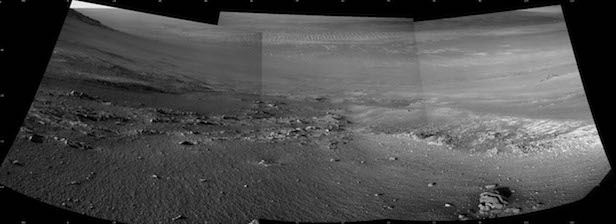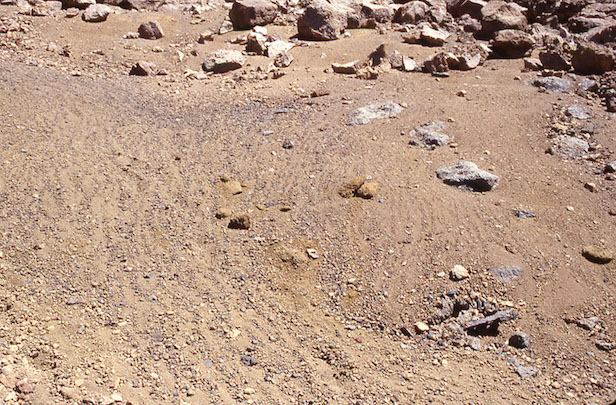NASA’s Opportunity rover continues to bring surprises about Mars
NASA’s Opportunity rover has pictured possible “rock stripes” on Mars, which on Earth, are formed by wet soil

NASA scientists are intensely studying textured rows on the Martian ground in order to uncover if this area was affected by water. Image credit: NASA/JPL-Caltech
As NASA’s Mars Exploration Rover Opportunity reaches its applaudable 5,000th Martian day, also known as a sol, it still continues to picture interesting and inquisitive features on the surface of Mars. Opportunity ventured along the Perseverance Valley where came across a familiar sight, a feature that could be possible “rock stripes”. On Earth, these features arise from repeated cycles of wet soil being frozen and melted, implying that astronomers could have found more evidence for water on Mars.
In recent images taken by the Opportunity rover, there appears a smudged version of noticeable stone stripes seen on some mountains slopes on Earth. We know that these features occur thanks to the continuous freezing and melting of wet soil. This would strongly suggest that water played a huge role in shaping this area of Perseverance Valley, however it could also be due to wind, downhill transport of material, other processes or even a combination.
“Perseverance Valley is a special place, like having a new mission again after all these years,” says Ray Arvidson, Opportunity Deputy Principal Investigator at the Washington University in St. Louis, United States. “We already knew it was unlike any place any Mars rover has seen before, even if we don’t yet know how it formed, and now we’re seeing surfaces that look like stone stripes. It’s mysterious. It’s exciting. I think the set of observations we’ll get will enable us to understand it.”
From what was supposed to originally be a 90-sol mission, has now been extended to almost a 5,000-sol mission, which is a remarkable achievement. This extended mission has led Opportunity into the western rim of the Endeavour crater, and more specifically, the channel called Perseverance Valley. Within this valley, some of the slopes contain soil and gravel particles that appear to be organised into narrow rows parallel to the slope, alternating between rows of less and more gravel.
What has happened in the valley’s past is high uncertain, however the rover-team scientists are carefully analysing any possible clues for water, wind or ice interaction. The scientists are carefully considering a wide range of explanations for these stripes, as well as trying to deduce if these processes occurred relatively recently or in the much distant past, when the environment was much different.

NASA scientists are intensely studying textured rows on the Martian ground in order to uncover if this area was affected by water. Image credit: NASA/JPL-Caltech
There is the possibility that water came from Mars’ poles. Mars experts state that over the course of hundreds of thousands of years, The Red Planet will go through cycles where its tilt or obliquity of its axis increases greatly. As the tilt or obliquity increases, the water, which is now frozen at the poles, will evaporate into the atmosphere, forming snow or frost to accumulate near the planet’s equator.
“One possible explanation of these stripes is that they are relics from a time of greater obliquity when snow packs on the rim seasonally melted enough to moisten the soil, and then freeze-thaw cycles organised the small rocks into stripes,” says Arvidson. “Gravitational downhill movement may be diffusing them so they don’t look as crisp as when they were fresh.”
Bernard Hallet of the University of Washington, Seattle, United States, agrees that the stripes in the Perseverance Valley are not as distinct as the stone stripes he has seen on Earth. Measurements of similar features have taken place at the summit of Hawaii’s Mauna Kea volcano, where soil freezes every night but is mostly dry. Field measurements of this area have revealed how they form when the temperature and ground conditions are ideal. The results show that soils with a mix of silt, sand and gravel expand more when the finer-grain material is most widespread and retains more water. As it freezes, it expands the soil and pushes the larger particles up. These particles reach the sides and slide down the slope due to gravity or wind, moving further away from the finger-grain concentrations and stretch out down slope. In areas where the large particles are more concentrated, the ground will expand less. Repeating this process hundreds or thousands of times will result in the following pattern, where these parallel stripes appear.
It is known that Perseverance Valley holds rocks that have been carved by sand being blown uphill from the crater floor. Wind could also play a huge part in organising the larger particles into parallel rows. “Debris from relatively fresh impact craters is scattered over the surface of the area, complicating assessment of effects of wind,” says Robert Sullivan, an Opportunity science-team member of Cornell University, Ithaca, New York, United States. “I don’t know what these stripes are, and I don’t think anyone else knows for sure what they are, so we’re entertaining multiple hypotheses and gathering more data to figure it out.”
Keep up to date with the latest reviews in All About Space – available every month for just £4.99. Alternatively you can subscribe here for a fraction of the price!




